Vol. 1, Issue 20
Posted: Thursday 18th June 2020
In C L N 19 I wrote about the Paris-Roubaix gear but I forgot to mention that the alternative, up to then, had been for Tour riders to stop and then turn the wheel round to get a lower gear for the mountains. The riders were equipped with just two freewheels on a double-sided hub so that puts the complexities of the gear into some perspective. As a follow up to that piece I have two images and some text sent by David Carpenter who is, as you can see, a very keen marque enthusiast:
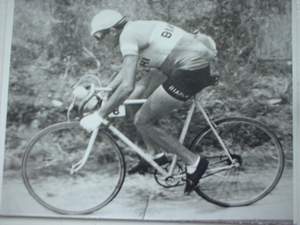
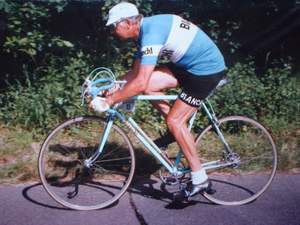
“The b/w photo was taken by Harry Aspden when he was in Southern Italy in 1947. It shows Fausto Coppi on the Foggio-Pescara stage . This is the Campag Cambio Corsa era: note that the chainwheel does not have the inner triangle. Also note the small frame and crouched position compared with later years. I attempted to duplicate the picture when I got my P-R bike on the road (With the help of nephew Steven.) It is difficult to spot the difference between a P-R and Corsa gear at this angle.”
“No.36 was the frame (288595) I bought in 1952 from Matt Newton, bit by bit, as soon as I started work. The brakes were the Universal 51’s with white rubber hoods and white rings on the lever cable adjusters. I thought that the shallow front stirrup indicated ‘pukka’ racer models, but I still managed to fit continental mudguards + panniers when I rode it down to the Pyrenees to see the TdF in 1954, using the original 49T ‘Bianchi’ ring with a 14-16-19-23-24 Regina block (see the c/w on No.14). I found the T.A double c/w 46/50 in a wonderful bike shop in Tarbes, together with ‘Pirelli’ Specialissimo corsa Tubs. It was still on the ‘Campag’-NISI sprints! I fitted the T.A. chainwheel when I got home using a ‘Magistroni’ crank. No.36 is now fitted with the later ‘Gran Sport’ gear and bare gear cables – my favourite configuration. The ‘Paris Roubaix’ gear lay unused until I retired 10 years ago when I managed to get a second frame (288741) and built up No.14 – a replica of the bike Coppi rode in the 1950 G.P.Campagnolo, after his ‘P-R’ win. That bike must have been very clapped. We climbed the Aubisque, Tourmalet and the Aspin.”
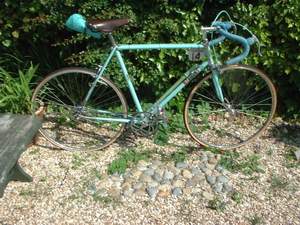
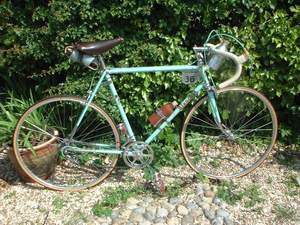
Could readers make a note of the frame numbers of any ‘Bianchi’s they come across so that David can keep track of them? His details are in the V-CC year book or if you are not a member I will forward information to him. Once again, I have larger, clearer images of these machines which can be sent as email attachments on request.
David Palk tells me that he and Alex von Tutschek are researching Pat Skeates who built lightweight frames from his small shop in Clapham C.’50-’54. They feel that he produced some of the finest lugwork ever and that even his basic frames had sophisticated features. If you happen to own one they would like details of frame numbers and description, or anything you may know about the company. Both David and Alex are in the V-CC handbook.
Also in Hampshire, Mervyn Cook recently read an article in a late 1933 ‘Cycling’ mag on the first lightweight show at the Royal Horticultural Halls, which includes reference to F.H.Grubbs new “all duralumin Universal brakes – of fine Italian manufacture”. This is two years earlier than we previously thought? We have passed this information on to Universal brakes weltmeister Bryan Clarke as additional material for his treatise on them.
Mervyn is not the only one who spends his valuable potential DIY time leafing through old copies of ‘Cycling’. I was searching through editions for the year 1954 looking for a picture of Dave Bedwell riding the 1954 Worlds on a Rivetts machine, unsuccessfully as it happens, although I had been told that there was such an image. Every reference to him throughout this year related to the Hercules team. We have a 21” Rivetts frame here which is waiting for a home restoration for Patricia to add to her collection.
We had thought of fitting it with a Sturmey gear to keep it simple but it has brazed on derailleur gear fittings and we would never cut them off and destroy the originality of the frame. Simon Carter from Stowmarket tells me that he can remember a dark green Rivetts machine exhibited in the window of their shop in Leytonstone, this was said to be the one used by Dave Bedwell in the Worlds. I had been planning to restore this frame in dark green so that is a stroke of luck. I have since noticed in adverts of 1957 that Bedwell was riding for Rory O’Brien of Romford.
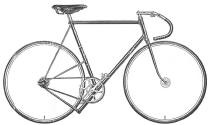
What I did come across though was detail of a Viking track machine known as the ‘Viking S.B.U. Tracker’ – 1954. Another entry for ‘Great British Inventions Which Changed the World’.
In the ‘Cycling’ road test they state: ‘SBU (Short-Wheelbase Underslung) design was arrived at after extensive research into lateral and torsional twisting stresses’. I wonder if the design team moved on to BMC to concoct the Allegro as the car to ‘conquer Europe’!! As you can see, there are two pairs of chainstays, an upper and a lower, and the down tube extends down beyond the BB for an estimated 28cm. Viking state that “The SBU separates the two stresses and concentrates each at a different point”, yes, yes we know. Originally, in 1953, this frame only had the lower chainstays but the upper ones were introduced in 1954 – well there’s a surprise, you would never think that a big open quadrilateral would be more flexible than a smaller triangle would you?. They could have fixed the new stays from the rear-ends to the BB and cut off all the tubing below! The BB is in a lug behind the junction of the down and seat tubes, giving a short rear triangle of 16”.
Having scorned this machine I must admit that I would love to have one as they must be almost unique. Has anyone ever seen one? The 1954 specification was: Brampton Alatet headset, Baylis Wiley ‘Featherweight’ BB, Williams 5-pin inch-pitch chainset with Italian Noli and Catteano quill pedals. Christophe toeclips with AL-E straps. Brooks B17 Narrow or Sprinter. Wheels had Weinmann ‘Scherens’ sprint rims on Airlite LF hubs fitted with Cyclo domed track-nuts. Cinelli bars and stem with 15½” ‘Gran Fondo’ deep drops.
I later noticed a reference to the Resilion Crimson Star derailleur gear in a magazine, ‘Sporting Cyclist’ February 1959. It seemed to imply that this was a new gear being launched as ‘the silent gear with the perfect change’. I mention this in case anyone is trying to date this changer with the red nylon sprockets. I have never seen one, or if I have, not registered it as a Resilion. In the same edition I saw a photograph of Harry Aspden who was writing an article called ‘Twelves are Poison’. I noticed that his geared machine had the rear brake fitted in front of the seat stays rather than behind as is usual.
I do tend to rabbit on about the shortage of materials available to builders right through from the end of WW2 to the early 50’s. I feel that this is one of the reasons for frames, etc of this period not always being to quite the expected specification. In this respect I understood that there had been a shortage of suitable lugs at this time, and that some builders were probably using pre-war lugs which would not be of the desired angle. I had been told that these builders placed strong sections of tubing into the lugs and forced them to the angle they wanted. I was therefore interested to find the following paragraph in the introduction to the Carpenter catalogue, 1949/50: “All frames are jig built, ensuring absolute accuracy. Tubes are mitred and pinned into special angled lugs, properly filed and lightened. We have lugs of all angles, and do not resort to the dangerous practice of lug pulling.”
At a local section Meeting, Tom Culver brought along a fascinating book of bound volumes of Cycling World from 1896. Most of the front pages had a full page studio image of a woman cyclist, usually titled and dressed in finery – think Tatler and you will get the idea. It was mentioned that the Prince of Wales had bought two tricycles. It got me thinking how things change over the years and that by 1946 cycling was in the main a working class thing. If you are the sort of reader who is interested in cycles to the detriment of all else then do not bother to read on.
In about 1948 I was out cycling with a small group when were invited to call in at the home of a club member on the ride. It was a Nissen hut which, to the uninitiated, is a semi-cylindrical building made of corrugated steel with windows, a door and a wood/coal burning stove in the middle. During the war this had been part of a prisoner-of-war camp. When we got inside I realised that the walls had a peculiar sheen – I soon realised that this was ice about one inch thick and that the only ice-free area was above the stove. Vic lived here with his totally deaf wife and their new-born child. Their mode of transport was a tandem fitted with a sidecar.
As a follow on to the above paragraph there is a bit of British history that has been suppressed for all these years which is as follows (very abridged):
During the war military personnel had been told that they would return to a land fit for heroes. As the result of wartime bombing millions of houses had been destroyed. At the end of the war thousands of returning troops wanted to get married to their sweethearts and there was nowhere for them to live. There were no materials to commence a massive housebuilding project. The result was that they would get married and live with their parents, there may be two or even more in the one family wanting to do this. It was not uncommon for a small house to have the original householders plus two more married couples and of course within a short time children as well. This could be in a small terraced house with an outside toilet and a tin bath.
Whilst all this was going on there were thousands of buildings unoccupied as the war was over. There were barracks, camps, prisoner-of-war camps plus thousands of requisitioned buildings used for offices and administration uses. Organisations dealing with this homeless problem pleaded with the government to free up some of this property to be used as homes but all requests were met with a blank refusal.
Here is where the Communist party came in and decided to take some positive action. Secretly they planned a countrywide mass take-over of much of this property and on a given day thousands of citizens marched in to occupy them. The government response was to cut off all services so the residents had no water on site and had to survive using paraffin lamps and heaters and often had to fetch water from a great distance. A campaign was also mounted to vilify the occupiers so they were often refused service in local shops, etc and were scorned by the populace living nearby. Children attending local schools were vilified.
Vic, at the start of this story, considered himself to be one of the country’s lucky ones as he had somewhere to live.
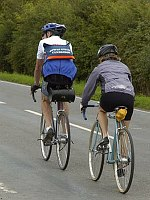
I often wondered if I had imagined all of this but several months ago Radio 4 did a programme on the subject and interviewed many of the occupiers and told their stories. I always felt that this episode in my life was suppressed information because governments did not want to let the populace know what could be achieved by an organised mass action.
Eventually the government initiated a massive building programme of pre-fabricated buildings as a stop-gap and this was followed by another extensive programme of council housing incorporated with slum-clearance projects. My excuse for including this diatribe in CLN is that it affected many cyclists of the time. I should point out that all the occupiers were hard working citizens who just wanted to find somewhere to live. This is why I have not used the word ‘squatters’ which is associated with a totally different type of person.
Posted: Thursday 18th June 2020
This article appears in the following categories.
Upcoming Events
Whether you are looking for a gentle social meet up, or a 100-mile ride browse the community’s upcoming events and plan your next weekend outing.
